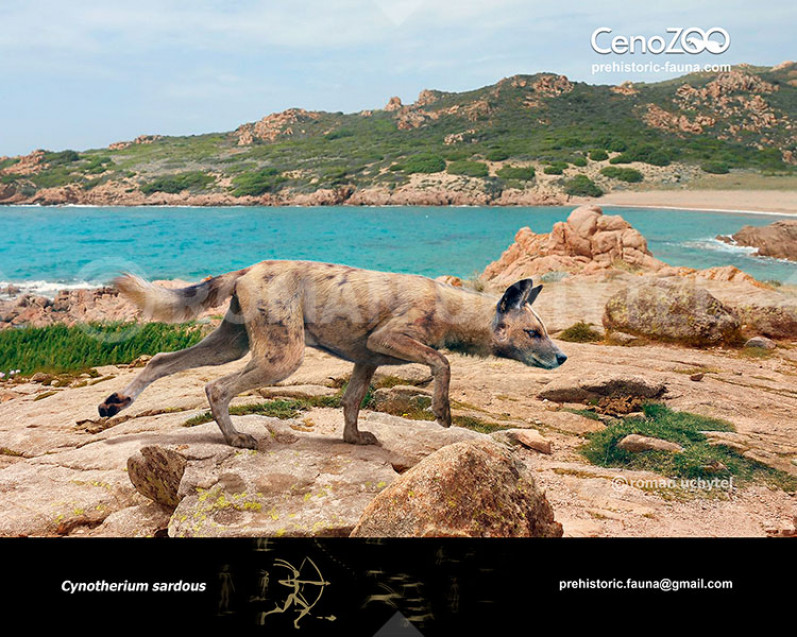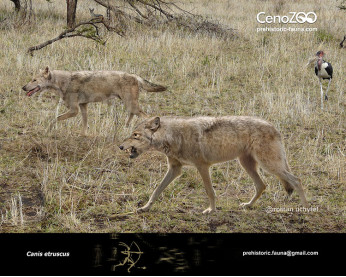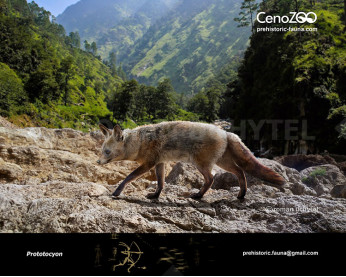Sardinian dhole
562562
Sardinian dhole (†Cynotherium sardous (Studiati, 1857))
Order: Carnivora
Family: Canidae
Temporal range: during the Pleistocene - Holocene (Europe, Mediterranean islands of Sardinia and Corsica)
Dimensions: length - 1,1 m, height - 50 сm, weight - 10 kg
The Sardinian dhole is an extinct insular canid which was endemic to Sardinia and Corsica during the Pleistocene. It went extinct when humans began to settle on the island.
The oldest fossils of the Cynotherium lineage on Sardinia, belonging to the species Cynotherium malatestai likely ancestral to C. sardous date to the Early-Middle Pleistocene transition, corresponding to faunal turnover between the older Nesogoral Faunal Complex and the younger Microtus (Tyrrhenicola) faunal complex. Its ancestor probably was Xenocyon, which means its closest relative is the modern African wild dog, Lycaon pictus.The genomic analysis showed low genomic diversity which may have led to the extinction of this dhole.
When the ancestor of this canid became confined to the island, its diet became limited to small and fast prey, such as rodents and lagomorphs (Sardinian pika (Prolagus sardus)). This lack of large prey caused the Sardinian dhole to evolve into a small sized. This view of Cynotherium as a predator specializing in small, fast prey is supported by an examination of the animal's anatomy. The evolution of powerful limbs, a low neck carriage and increased head and neck mobility suggests an animal well suited for stalking and then quickly pouncing on or running down small prey. Its ears were probably quite large for detecting its prey.
Оплата
У Вас є кілька зручних способів купівлі зображення: кредитна чи дебетова картка Visa, Mastercard, Maestro; PayPal або банківський переказ
Sardinian dhole (†Cynotherium sardous (Studiati, 1857))
Order: Carnivora
Family: Canidae
Temporal range: during the Pleistocene - Holocene (Europe, Mediterranean islands of Sardinia and Corsica)
Dimensions: length - 1,1 m, height - 50 сm, weight - 10 kg
The Sardinian dhole is an extinct insular canid which was endemic to Sardinia and Corsica during the Pleistocene. It went extinct when humans began to settle on the island.
The oldest fossils of the Cynotherium lineage on Sardinia, belonging to the species Cynotherium malatestai likely ancestral to C. sardous date to the Early-Middle Pleistocene transition, corresponding to faunal turnover between the older Nesogoral Faunal Complex and the younger Microtus (Tyrrhenicola) faunal complex. Its ancestor probably was Xenocyon, which means its closest relative is the modern African wild dog, Lycaon pictus.The genomic analysis showed low genomic diversity which may have led to the extinction of this dhole.
When the ancestor of this canid became confined to the island, its diet became limited to small and fast prey, such as rodents and lagomorphs (Sardinian pika (Prolagus sardus)). This lack of large prey caused the Sardinian dhole to evolve into a small sized. This view of Cynotherium as a predator specializing in small, fast prey is supported by an examination of the animal's anatomy. The evolution of powerful limbs, a low neck carriage and increased head and neck mobility suggests an animal well suited for stalking and then quickly pouncing on or running down small prey. Its ears were probably quite large for detecting its prey.


-797x638.jpg)

-70x56.jpg)

-lycanoides-346x277.jpg)

-346x277.jpg)